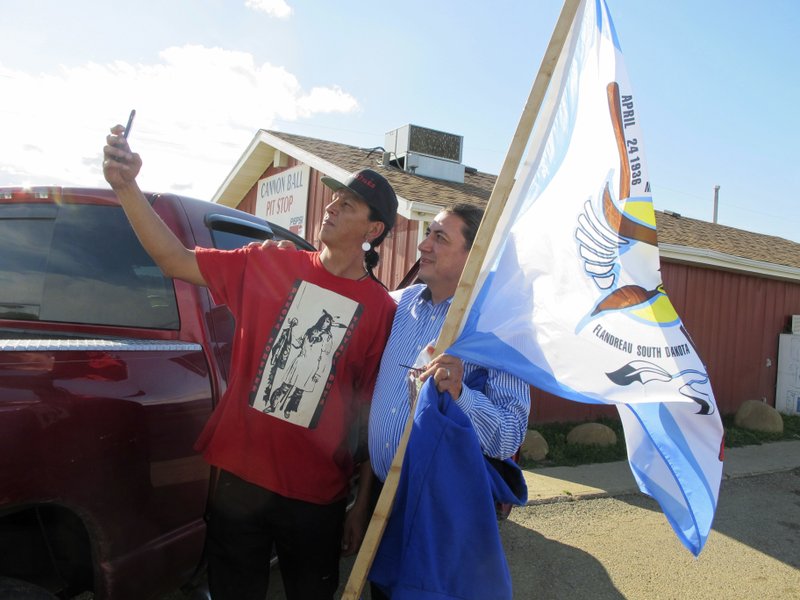STANDING ROCK SIOUX RESERVATION, N.D. -- High on a hill overlooking the confluence of the Missouri and Cannonball rivers, Dave Archambault II knelt and touched a stone that bears a handprint worn into it by thousands of his ancestors who have done the same for centuries.
There, the leader of the Standing Rock Sioux Tribe said a prayer for peace.
Below, Archambault could see American Indians from across North America gathered at an encampment a half-mile away, joining his tribe's growing protest against a $3.8 billion four-state oil pipeline that will cross the Missouri River nearby. It's a project they fear will disturb sacred sites and affect drinking water for thousands of tribal members on the Standing Rock Sioux Reservation and millions farther downstream.
"Our cause is just," the 45-year-old said. "What we do today will make a difference for future generations."
Archambault's contemporaries say he's the right person at the right time to lead the fight, which has led to the arrests of about 30 people, Archambault included, for interfering with construction of the Dakota Access pipeline.
On Saturday afternoon, the protest against the pipeline turned violent after construction crews destroyed American Indian burial and cultural sites, tribal officials said.
Morton County sheriff's office spokesman Donnell Preskey said four security guards and two guard dogs were injured after several hundred protesters confronted construction crews at the site just outside the Standing Rock Sioux reservation.
Tribe spokesman Steve Sitting Bear said protesters reported that six people had been bitten by security dogs, and at least 30 people were pepper-sprayed.
Preskey said the crowd dispersed when officers arrived and that no one was arrested.
Since becoming the leader of about 9,000 people in 2013, Archambault has sought to improve housing, health care, employment, education and other problems that his 2.3 million-acre reservation, which straddles the North Dakota and South Dakota border, and other reservations nationwide face.
Now, he's dealing with added pressure of the pipeline, which he has called yet another "historic wrong" involving tribal sovereignty and land rights.
The Standing Rock Sioux Tribe sued federal regulators for approving the pipeline, challenging the U.S. Army Corps of Engineers' decision to grant permits. The company has temporarily halted construction, and a federal judge will rule before Friday on whether that break will last.
Archambault and others also have been sued by Dallas-based Energy Transfer Partners for interfering with the pipeline, which will pass through Iowa, Illinois, North Dakota and South Dakota.
Former North Dakota U.S. Attorney Tim Purdon, who is representing Archambault and other tribal leaders in that suit, said that it's nothing more than an attempt to silence the tribal leader.
"I think they think he is a voice for the people that no one can control," Purdon said. "From the first day I met him, I could tell he is a very serious person who really has the best interests of his people -- and the people of North Dakota -- at heart."
Archambault has for years spoken of concerns among the leaders of North Dakota's five American Indian reservations about "the increasing number of environmental incidents" in western North Dakota's oil patch -- far from his own territory. He appealed to lawmakers to do more to protect public safety and the environment.
That was before his tribe was aware of the Dakota Access pipeline, for which developers have promised safeguards, noting that workers monitoring the pipeline remotely in Texas could stop any leak within three minutes.
It's not enough for Archambault, who worries a breach would destroy sacred sites and ancestral burial grounds well beyond the reservation's boundaries.
"Anything that is man-made is going to come apart," he said, pointing to a 2013 spill in northwestern North Dakota that was among the largest inland spills in North America. It was discovered only after a farmer got his tractor stuck in the muck while harvesting wheat; it's only half cleaned up, despite crews working around the clock since it happened, state health officials say.
Archambault has the full backing of the leader of North Dakota's oil-rich Mandan, Hidatsa and Arikara Nation.
And Archambault is buoyed by the scores of protesters who have come to help his tribe's fight. On a recent afternoon, Monte Lovejoy, a member of the Oglala Sioux tribe on the Pine Ridge Indian Reservation in South Dakota, embraced Archambault and thanked him.
"I really couldn't afford to come up here," he told Archambault, whom he'd never met before. "But I really couldn't afford not to, for my kids and for my people."
A Section on 09/04/2016

